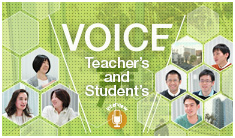- Home
- Teacher's and Student's voice
- Takashi Kanamori
Takashi Kanamori


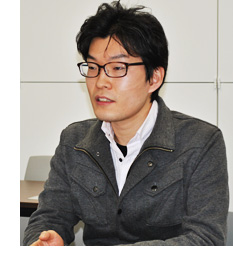 Kanamori: My specialty is the field of Bioorganic Chemistry. I have been carrying out research on the theme of design and synthesis of "fluorescent probes" that glow when they find a target.
Kanamori: My specialty is the field of Bioorganic Chemistry. I have been carrying out research on the theme of design and synthesis of "fluorescent probes" that glow when they find a target.
I myself was a student at Tokyo Institute of Technology from the time I was an undergraduate right through to the Doctoral Course at the Graduate School. When I was a student in the doctoral program, we used to hold discussions with undergraduates and Master's Course students in the laboratory while we were conducting our research. From that experience, I started to feel an interest in teaching newer students while studying together. There is a joy in realizing that a student you have been conducting research with has "made progress". Through helping students to progress, my own motivation to make progress increases. I felt that the opportunity for both of us to learn things at the same time was attractive.
Then, just when I was finishing my Doctoral Course, I learned about the existence of ACLS. The importance of studying the two fields of life sciences and information sciences together, and the interest and value of teaching, those were the two things that made me decide to apply to ACLS.

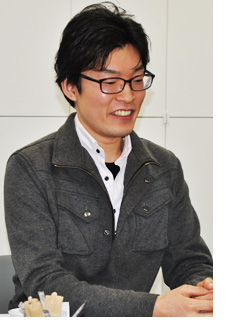 Kanamori: At ordinary university graduate schools, they use a method of study in which students study one specialist field in depth for 3 years. It is built around fostering the ability to solve problems, together with intensively studying ways of thinking. Even when they come into contact with the challenges of a new field, the goal is for them to be able to adapt the ways of thinking they have internalized and then solve the problems.
Kanamori: At ordinary university graduate schools, they use a method of study in which students study one specialist field in depth for 3 years. It is built around fostering the ability to solve problems, together with intensively studying ways of thinking. Even when they come into contact with the challenges of a new field, the goal is for them to be able to adapt the ways of thinking they have internalized and then solve the problems.
However, in order to adapt their way of thinking, it is necessary for them to have flexibility at the time when they first came in contact with fields outside their specialist field. This is not limited to only the specialist fields, it is also important to be able to proactively discover various research themes yourself. I think the ACLS program, which brings researchers into contact with other fields while they are still students is effective at imparting that flexibility and pro-activeness. So in addition to the one thick leg of the specialist field, we are nurturing the seeds of growth in another field. As a result, when the students come into contact with another field, they will be able to respond flexibly. I think it is an extremely attractive program. The contents are highly applicable, and it is a great opportunity for the students who take part.
I myself really feel the merit of this way of studying two subjects together. In the design of fluorescent probes, which is my specialty, it is necessary to skillfully employ the techniques of information science. When evaluating results too, even in evaluating them and explaining the principles on which they operate, the methods of information science (quantum chemistry calculations and particle simulations) have become indispensable. I think it also has an application in the sense that by deepening my knowledge and experience of information science, I can create more attractive compounds. So that is something that I personally am learning by participating in the program.

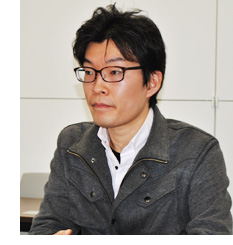 Kanamori: At ACLS, there are instructors from both life sciences and information sciences. I am involved, on a daily basis, not only with people from my own specialty, but with instructors from other fields as well, so I feel benefit in various ways. For example, ideas for new themes emerge from discussions with lecturers whose specialty is synthetic biology or molecular simulation, and so on. I have discovered various things that have widened and deepened my own specialist knowledge. Also, the positions that instructors from the life sciences and information sciences take about things is different, from which I have received a refreshing stimulation.
Kanamori: At ACLS, there are instructors from both life sciences and information sciences. I am involved, on a daily basis, not only with people from my own specialty, but with instructors from other fields as well, so I feel benefit in various ways. For example, ideas for new themes emerge from discussions with lecturers whose specialty is synthetic biology or molecular simulation, and so on. I have discovered various things that have widened and deepened my own specialist knowledge. Also, the positions that instructors from the life sciences and information sciences take about things is different, from which I have received a refreshing stimulation.
As a Specially Appointed Education Staff member, I am working in education, so it is different to the career of a researcher who is only doing research. Through this experience, I feel that the value of the increase in the breadth and depth of my knowledge in my specialist field, and the widening of network of connections to other fields and other people, is exceptionally large.

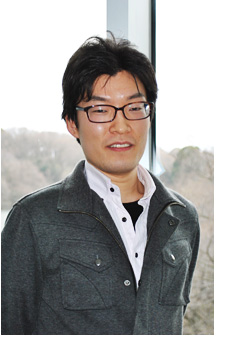 Kanamori: At ACLS we have the principle of "Producing students with high communication abilities for the industrial world”. Creative Collaboration Works are one of the characteristic programs that make this principle into a practical reality. Life science and information science students form a team and provide a mutual stimulus to each other as they cooperate to deliver a presentation. Students deepen their "pivot foot" in their specialist field, while engaging in communication with students from another field.
Kanamori: At ACLS we have the principle of "Producing students with high communication abilities for the industrial world”. Creative Collaboration Works are one of the characteristic programs that make this principle into a practical reality. Life science and information science students form a team and provide a mutual stimulus to each other as they cooperate to deliver a presentation. Students deepen their "pivot foot" in their specialist field, while engaging in communication with students from another field.
The theme I am responsible for is a "Development of RNA aptamers in a directed evolution technique (SELEX)". This theme relates to nuclear medicine, which has come under attention as a next generation pharmaceutical development method. So we held a seminar on obtaining RNA aptamers, which bind to a specific substance.
The exercise was carried out continuously over a period of about one week. Students formed a three man team, consisting of two life sciences students and one information sciences student, and multiple teams conduct experiments and analysis at the same time. The central part of the seminar, isolation of RNA aptamers, is almost entirely a life sciences experiment. A variety of RNA possessing random sequencing is mixed with the target substance, and only molecules that are specifically bound are extracted. In a single experiment bonds might also be formed with extraneous material, so the cycle is repeated as many times as necessary until finally the RNA aptamer is found. In the current seminar, we are also adding information science methods to it, by conducting quantum chemistry calculations of the target substance used in the experiment, and predicting its physical properties.
Seeing the students tackling these exercises, I feel that we have achieved a definite result from these seminars. Firstly, by selecting something close to a cutting edge topic as the theme, I think we are getting them to take it up with the fresh feeling of "Life science students are doing something for the first time too". Even in relation to the thing called mutual communication, it is an opportunity for information science students to see "what a wet experiment looks like". The effect on life sciences students is "Letting them take things that they would normally do routinely, and reconfirming their knowledge by getting them teach this knowledge to the information science students." In addition, for the life sciences students, it is an opportunity to find out what happens when you predict the result of an experiment you are going to do using a computer. The students from the different fields mutually cooperate, while studying themes that are close to the cutting edge of research, so I think it's a good experience, don't you?

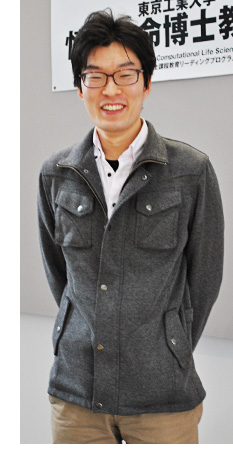 Kanamori: Specially Appointed Education Staff and coordinators divide up responsibility between each other for supervising all the students, and provide each and every one of them with detailed support. The background aim is to verify that we are putting the principles of ACLS into practice. They learn as a fusion of information science and life science. That is important. However, it is very different from existing teaching programs, so it is necessary to check its progress. Hearing the opinions of the students and adapting to them, makes the ACLS program even better. It's that kind of system.
Kanamori: Specially Appointed Education Staff and coordinators divide up responsibility between each other for supervising all the students, and provide each and every one of them with detailed support. The background aim is to verify that we are putting the principles of ACLS into practice. They learn as a fusion of information science and life science. That is important. However, it is very different from existing teaching programs, so it is necessary to check its progress. Hearing the opinions of the students and adapting to them, makes the ACLS program even better. It's that kind of system.
The first time was in October 2013, when we held an interview session to listen to the opinions of the students. I was also responsible for 7 students, and listened to what they had to say. I discussed their academic record, extracurricular activities, theses, and so on, based on the check sheet they filled in. At present, we are at the stage of carrying out evaluations based on the contents of such interviews. The goal of ACLS is "Fostering global leaders who can play an active role in industry", and we are evaluating how much progress we have made towards that goal.
In the latest interviews, we received some incredibly positive feedback from the students. Their evaluation of the program was high. This validates the highly bright foresight of the teachers who designed the ACLS curriculum. The flip side is that by studying fields outside of their specialty, their main axel became shorter, however, the feedback from the students was highly motivated, saying: "We received fresh, new, stimulation". They felt they had the effective functionality to try new things, and to the extent that their main axel became shorter (= less time devoted to their specialist subject) they had the feeling of strength/reliability that they would extend it in the future. Also the newly created shoots (knowledge in other fields) appear to be an advantage in making the horizontal stroke of the gamma symbol as long as possible.
In the future, we will set up an opportunity for interviews and evaluation once every six months. While running the course, I think that all of us in the ACLS staff, working together, will do our best to make it an even better system.
(Note)The contents of this article are accurate as of the time the interview was conducted in February 2014.






